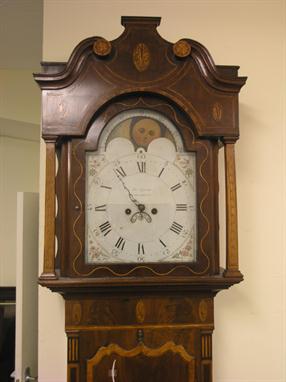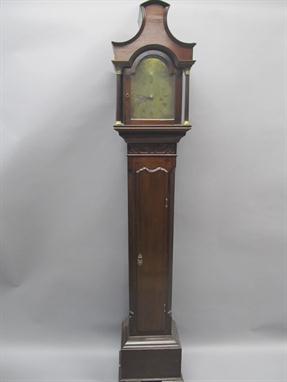A George III mahogany crossbanded oak cased striking eight day longcase clock by J. Stanyer of Nantwich, the square brass dial with engraved subsidiary seconds dial, date aperture, twin winding holes, engraved decoration and applied spandrels, with twin weights and pendulum, height approx 208cm (illustrated)
We found 44425 price guide item(s) matching your search
There are 44425 lots that match your search criteria. Subscribe now to get instant access to the full price guide service.
Click here to subscribe- List
- Grid
-
44425 item(s)/page
A George III mahogany crossbanded oak cased striking eight day longcase clock by T Richardson of Weaverham, the painted square dial with painted subsidiary seconds dial, twin winding holes, date aperture, and painted decoration with twin weights and pendulum, height approx 201cm (illustrated)
A late Georgian mahogany and oak cased striking eight day longcase clock inlaid with boxwood and ebony checkered banding, boxing stringing, and mahogany crossbanding, the painted arched dial featuring a painted hunting scene to the arch, fruit painted decoration to the corners, subsidiary seconds, twin winding holes, with twin weights and pendulum, height approx 230cm (illustrated)
An early 19th century late Georgian parquetry inlaid and mahogany banded oak cased thirty hour longcase clock, the painted arched dial inscribed 'W.Hullah, Wilsill', the movement striking on a bell, with single weight, and pendulum, height approx 226cm With this lot comes some family history which reads as follows 'Longcase clock made by Richard Snow, Pateley Bridge, clock maker 1822-1841, made circa 1829 for William Hullah of Wilsill 1804-1870. Passed to his son Joseph Hullah 1832-1882 and then to his son William Hullah 1862-1937. 'Plus further information and family tree. (illustrated)
A 19th Century oak and mahogany crossbanded longcase clock, painted arch dial with a scene of Caspar Steinkopft shot by Robin Hood, eight day striking movement, subsidiary seconds dial and date aperture, enclosed by a glazed hood with broken swan neck pediment, over a turned pillared door, on canted bracket plinth base, 212cm high
A 19th Century mahogany longcase clock, painted arch dial with eight day striking movement, moon phase, seconds and subsidiary dial and date aperture, indistinctly signed Manchester, enclosed by a broken swan neck pediment and spiral pilaster hood over a lancet door on crossbanded plinth base, 242cm high
An Oak Eight Day Longcase Clock, case with swan neck pediment, 12-1/2-inch arched brass dial, arch inscribed William Greaves Newcastle, moonphase, twin weight driven movement with rack striking on a bell, 230cm high Case surfaces have been cleaned throughout, metal mounts with gilding faded, pierced pediment has been restored, case with some later added moulding`s, later feet, chips and dents to edges in parts, dial with restoration, dial chapter feet appear to have been re-riveted and the dial plated does not appear to be original with the chapter ring, silvered dials need re-silvering, movement needs cleaning. AW130513
A Small Longcase Clock, with swan neck pediment, 8-inch painted arched dial, floral and shell decoration to the arch and corners, single fusee movement with anchor escapement, 190cm high Case has been cleaned to the surfaces and has lightened due to slight sunlight damage, some chips and dents in parts, wooden dial surrounded with damage, plinth with a crack, dial with paint lacking at 12 o`clock, later seatboard, movement needs cleaning. AW130513
A Marquetry Eight Day Longcase Clock, signed Ric Spittle, London, circa 1700, flat top pediment, side viewing windows, trunk door with floral, bird and scroll decoration, glass lenticle, plinth with matching decoration, 11-inch square brass dial, chapter ring signed Ric Spittle, London, date aperture, winged cherub spandrels, five pillar movement with anchor escapement and inside countwheel striking on a bell, later seatboard, 201cm high 31.01.13, Case has been totally restored, surfaces have been polished, due to the restored veneers the marquetry could possibly have been inlaid at a later date, veneers have been replaced in parts, hood with a later added fret, top caddy is now missing, top left and right hand sides of the backboard have been later added, trunk door with cracking in places, plinth with some cracks, skirting has been later added and also the bun feet, both side cheeks with slight packing with wood possibly due to the wrong seatboard, movement with a small screw missing which holds the click spring in place, due to this you are unable to wind the striking side of the movement at present, dial and movement look complete.
An Oak Eight Day Longcase Clock, with swan neck pediment, 14-inch circular painted dial inscribed A Crawshaw Rotherham, twin weight driven movement with anchor escapement and striking on a bell, 216cm high Case surfaces have been cleaned throughout later added moulding in parts, later feet, dial totally repainted, later seconds hand, cheeks with wooden packing beneath seatboard, movement looks complete, finial missing to the hood. AW130513
An early 18th Century brass longcase clock dial with eight day bell strike movement, the 12 inch square dial with silvered chapter ring inscribed `Jno Gavelle near London` framing a matt centre with subsidiary seconds and date aperture, all cornered by cherub and crown spandrels, width approx 30.5cm (lacking bell).
A George III oak longcase clock with thirty hour movement striking on a bell, the square painted dial with date aperture and inscribed `Munk Tenterden`, within a surround of Roman and Arabic numerals, the hood with a glazed door flanked by turned columns, the rectangular trunk door above a plain base, on bracket feet, height approx 193cm, with pendulum and weight.
A George V oak diminutive longcase clock with eight day movement chiming on gongs, the brass break arch dial with silvered chapter ring, the hood with moulded arch pediment and barley twist columns, the trunk door and base with geometric moulding on a plinth base, height approx 163cm, together with pendulum.
An 18th Century and later walnut longcase clock with eight day movement striking on a bell, the brass break arch dial with silvered chapter ring framing a matt centre with subsidiary seconds, date aperture and signed `Wm Barker, London`, cornered by pierced mask and scroll spandrels, beneath a silvered month and zodiac subsidiary dial to the arch, the hood with three brass ball finials above a moulded arch pediment, pierced blind fretwork frieze and glazed door, flanked by a pair of turned columns, the trunk with quarter veneered rectangular door on a plain base and plinth, height approx 233cm, together with two weights, winder and pendulum (alteration and restoration).
A George III and later mahogany diminutive longcase clock with eight day movement striking on a bell, the brass break arch dial with matt centre framed by a chapter ring with Roman numerals, beneath a circular boss to the arch inscribed `Grant, London`, all cornered with cast and pierced gilt metal mask and scroll spandrels, the hood with moulded arch pediment above a glazed door with turned columns, the trunk with arched door on a panelled base and bracket feet, height approx 138cm, together with pendulum (bob lacking) and weights (alterations and restoration). Provenance: Swan & Edgar Ltd, London sale receipt dated 16.7.1920.
An early 19th Century mahogany longcase clock with eight day movement striking on a bell, the painted break arch dial with subsidiary seconds and date dial, Roman numerals and inscribed `W.D. Baker, Horsham`, cornered and beneath gilt flower sprays, the hood with swan neck pediment and turned finial above a glazed door and turned columns, the trunk with rectangular door on a plain base and bracket feet, height approx 215cm, together with pendulum and two weights (alterations).
A George III oak longcase clock with thirty hour movement striking on a bell, the brass break arch dial with Roman hours and Arabic minutes, and inscribed `John Muzzell, Horsham`, cornered with pierced and cast mask and scroll spandrels, beneath a boss to the arch engraved with an eagle and inscribed `Tempus Fugit`, the hood with swan neck pediment and brass ball and eagle finial above a glazed door and turned columns, the shaped trunk door with inlaid shell paterae on a panelled base and plinth, height approx 211cm, together with weight and pendulum (alterations and restoration).
A mid-18th Century oak longcase clock with thirty hour movement striking on a bell, the square brass dial with Roman numerals framing a matt centre with date aperture and inscribed `Jno Tribe, Thackham`, cornered with pierced and cast mask and scroll spandrels, the hood with swan neck pediment above a glazed door and turned columns, the trunk with rectangular door on a plain base and bracket feet, height approx 203cm, together with pendulum, weight and winder.
A 20th Century Italian walnut longcase clock, the eight day Franz Hermle movement with Westminster chimes striking on eight gongs, the break arch dial with moonphase indicator above a silvered chapter ring with Roman numerals, the case with galleried caddy top above turned and spiral reeded columns, the glazed doors and sides inlaid with flowers, swags and scrolls, on ogee bracket feet, height approx 204cm, together with pendulum and three weights.
A mahogany longcase clock, late 18th century, the dial signed 'Sutton Liverpool', the arched brass dial with moonphase and inscribed 'Tempus Edax Rerum', with eight day striking movement, 231cm high CONDITION REPORT: Case has had repairs, niw pieces, patches hinges have been reset feet are replacements awkward and jagged cut out under seat board polish discolouration crude (replacement?) base panel dial lacquer has deteriorated and needs resilvering and lacquering movement needs complete clean no evidence of additions to top of head minute hand soldered blind fret above door seems crude
A marquetry longcase clock, early 18th century, by John Clowes, London, the movement with five finely finned pillars, the 11in dial with ringed winding holes, seconds and date mechanisms and outside count wheel, 208cm high CONDITION REPORT: Poor condition. Hood top has replaced mouldings and no fret or marquetry, now with red glass side panels. Movement has old replaced seatboard. Carcass has splits and cracks, marquetry veneer also affected by this. Base has added deep plinth covering lower part of marquetry panel. No lock on door. Marriage of dial and movement.
A Scottish mahogany longcase clock, the eight day striking half hours, the 12in painted dial inscribed K Murdoch, Ayr, with subsidiary seconds and calendar dials, in an uptapering case, 202cm high CONDITION REPORT: Clock case restored. Dial overpainted. Please view images of the movement with hood detached
A late 17thC eight day striking walnut longcase clock, the projecting cornice applied gilt metal swags to frieze above a 10" square brass dial with matted centre, subsidiary seconds and date aperture, winged cherub head spandrels, inscribed along lower edge `Henry Younge in the Strand`, flanked by a pair of round pilasters and side windows, the bell-striking movement with outside countwheel and five latched pillars, the case door with half-round mouldings, herringbone banding and circular lenticle, the plinth base cut down, Height 75"
Blackburn, Oakham, an 18th century and later pine longcase clock, the hood with cushion top above a pair of pilasters flanking a 12-inch square brass dial with Roman chapter ring and date aperture, having a 8-day two train movement with dead beat escapement, the trunk with moulded door and glazed aperture, on box base, 196cm high x 50cm wide. (associated case)
-
44425 item(s)/page


























































